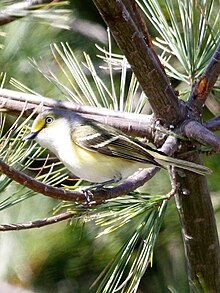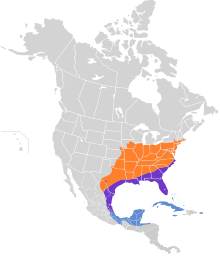White-eyed vireo
| White-eyed vireo | |
|---|---|

| |
| Scientific classification | |
| Kingdom: | |
| Phylum: | |
| Class: | |
| Order: | |
| Family: | |
| Genus: | |
| Species: | V. griseus
|
| Binomial name | |
| Vireo griseus (Boddaert, 1783)
| |

| |
The white-eyed vireo (Vireo griseus) is a small songbird. It breeds in the southeastern United States from New Jersey west to northern Missouri and south to Texas and Florida, and also in eastern Mexico, northern Central America, Cuba and the Bahamas.
Populations on the US Gulf coast and further south are resident, but most North American birds migrate south in winter.
This vireo frequents bushes and shrubs in abandoned cultivation or overgrown pastures. The grass-lined nest is a neat cup shape, attached to a fork in a tree branch by spider webs. It lays 3–5 dark-spotted white eggs. Both the male and female incubate the eggs for 12–16 days. The young leave the nest 9–11 days after hatching.
The white-eyed vireo is 13–15 cm (5.1–5.9 in) in length. Its head and back are a greyish olive, and the underparts are white with yellow flanks. The wings and tail are dark, and there are two white wing bars on each wing. The eyes have white irises, and are surrounded by yellow spectacles. Sexes are similar.
The white-eyed vireo's song is a variable and rapid six to seven note phrase, starting and ending with a sharp chick.
During the breeding season, the diet of this species consists almost exclusively of insects, primarily caterpillars. In the autumn and winter it supplements its diet of insects with berries.

Subspecies
Several subspecies are recognized for the white-eyed vireo. Geographic ranges for subspecies are not entirely clear.
The northern subspecies, V. g. noveboracensis, occupies most of the range of this species and is fully migratory. This sub-species is larger and has more brightly colored plumage than all other subspecies.
The resident southeastern coastal plain race, V. g. griseus is a slightly smaller and duller colored subspecies. It does not typically migrate out of its breeding range in the winter.
The resident Florida Keys race, V. g. maynardi, is greyer above and whiter below, and the south Texan V. g. micrus is like a smaller maynardi.
V. g. bermudianus is endemic to Bermuda.[2] This has shorter wings and a duller plumage. Along with other endemic and native Bermudian birds, it was threatened with extinction following the loss of 8 million Bermuda cedar trees in the 1940s, and is now quite rare. This species is listed under the Bermuda Protected Species Act 2003.
References
- ^ Template:IUCN
- ^ "White-eyed Vireo". Bermuda Department of Conservation Services. Retrieved 8 March 2014.
{{cite web}}: External link in|website=
External links
- Bermuda Department of Conservation Services, White-eyed Vireo page
- Bermuda Online: Bermudian Fauna
- Nature Conservation in Bermuda at Cave Biology.Com
- White-eyed Vireo Species Account - Cornell Lab of Ornithology
- Bird Banding at Caddo Lake (includes White-eyed Vireo photo)
- White-eyed Vireo Bird Sound at Florida Museum of Natural History
- "White-eyed Vireo media". Internet Bird Collection.
- White-eyed Vireo photo gallery at VIREO (Drexel University)
- White-eyed Vireo species account at Neotropical Birds (Cornell Lab of Ornithology)
- Interactive range map of Vireo griseus at IUCN Red List maps

